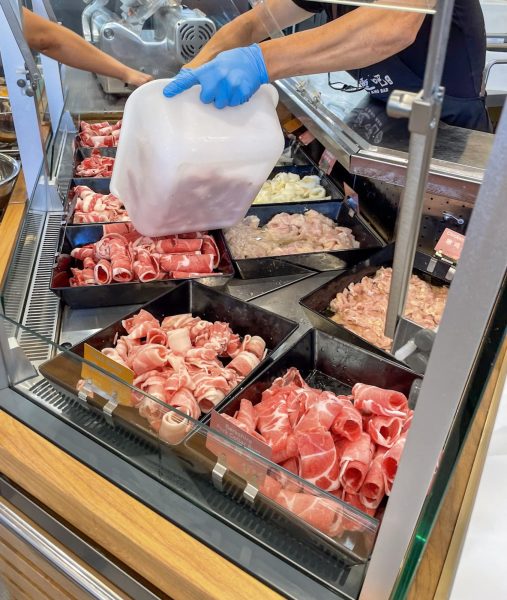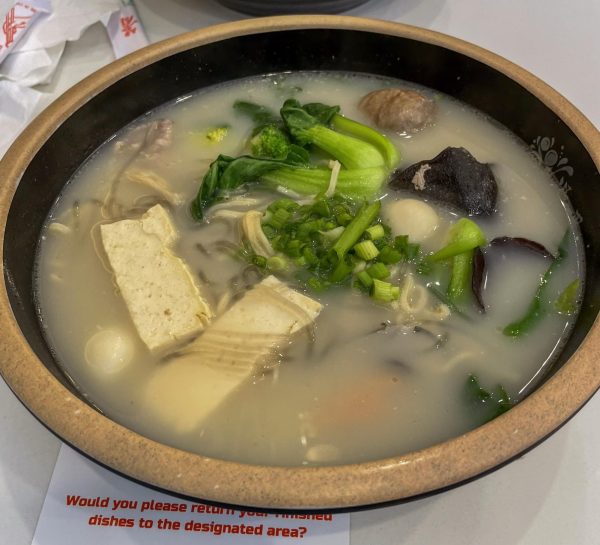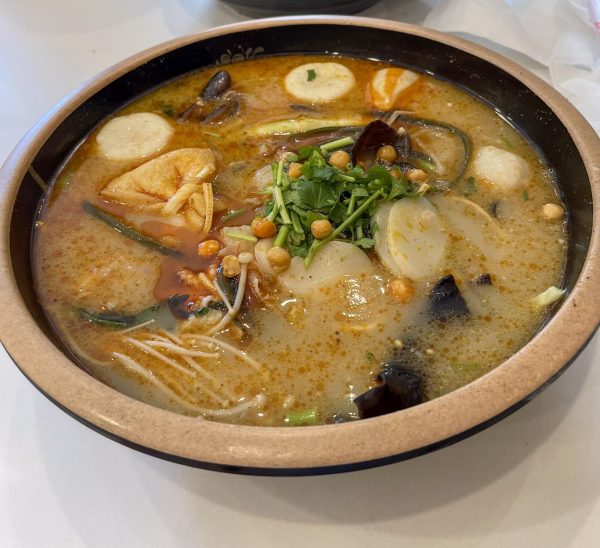The rich aroma of Sichuan spice and savory chicken broth fills the air at Tang Bar, where vibrant displays of fresh vegetables, thinly sliced meats and noodles invite diners to craft their own hot pot dishes.
Tang Bar’s soft opening in August of its second location, at 62 E. 4th Ave in San Mateo, marks the arrival of a new trendy way of eating hot pot — and is worth the drive for Palo Altans interested the restaurant’s bold experiment.
Traditionally, hot pot restaurants focus on group dining, where families and friends gather around a pot on the table to cook an assortment of ingredients together. Tang Bar, however, caters to a different crowd. Diners select their ingredients from a buffet-style ingredient bar and then weigh their selections to determine the price. After choosing their soup base, the staff cooks the hot pot for them. This setup is particularly appealing for people dining alone or those who prefer not to cook but still want to enjoy a hot pot meal.
According to Henry Lin, owner of Tang Bar San Mateo, the concept of staff-assisted build-your-own hot pot is especially popular due to its convenience.
“In traditional hot pot places, customers and families gather so they cook together with all the different ingredients,” Lin said. “But for the people who work during the daytime or for the younger generations, they might also want hot pot, but with more options and without the headache from cooking.”
As people queue up to grab their food during the lunch rush, friends and families chatter at each table. Decorated with faux bonsai trees, pebbles along the walls, twinkle lights on the ceiling and a small fountain running down a long table, the restaurant conveys a peaceful and tranquil vibe.

Diners grab a metal bowl and tongs to choose their ingredients. To ensure these ingredients are kept fresh, Lin said the workers must replenish them often.
“Our ingredients go out very fast,” Lin said. “For example, we order almost two cases of each kind of meat twice a week because of the popularity. We also carve and serve the meat so we can always make sure the food is very fresh and still going out fast.”
The journey begins with an array of thinly sliced meats: beef, pork, lamb, chicken, fish cutlets and organ meats such as beef tripe and aorta.
Next, diners encounter a section dedicated to fish balls such as cuttlefish and ones stuffed with cheese or roe. Additional proteins include squid, shrimp, tofu and quail eggs.
The vegetable section offers options such as napa cabbage, bok choy, and traditional Asian vegetables such as kelp and bamboo shoots. Adjacent are various types of mushrooms including wood ear and enoki mushrooms. Lastly, the starches section feature ramen, yam noodles and rice cakes.
Once diners finish selecting their ingredients, they can choose to have their food cooked two ways: malatang (served with broth) or stir-fried in a “savory mix” (served with sauce). For the malatang option, there are five different broths ranging from mild chicken broth to Sichuan spice, catering to all spice levels. For the savory mix option, diners can choose from four different sauces: sesame, spicy and sweet, Sichuan peppercorn or Sichuan spicy.
At the cashier, the bowl is weighed to determine the price, set at $15.99 per pound. For my two bowls weighing 1.42 and 1.65 pounds, the total came out to $53.82, including tax. Given that this establishment charges by weight, the cost can add up quickly if you grab many ingredients. However, the quality and variety of food make it worthwhile.
This establishment is primarily self-service. After paying, diners wait for their order number to appear on the television screen to pick up their dish. After eating, customers return their bowls to a bin near the kitchen.
While waiting, customers can head over to a counter to get utensils, complimentary water cups and wet wipes.
Despite the pleasant experience so far, one drawback is the wait time; the food was ready for pick-up about 40 minutes after placing the order. Although the wait was longer than expected, the piping hot bowls of hot pot were worth it. Here is what I found.

Chicken Broth Malatang:
This bowl of malatang is perfect for those who prefer a non-spicy base. The chicken broth is rich and salty, serving as a comforting foundation for the ingredients. The chicken and beef are cooked just right, soft and tender. I also added more protein including tofu and quail eggs to balance out the umami flavor, absorbing the broth while they were simmering. Additionally, vegetables such as oyster mushrooms, bamboo shoots and wood ear add a bright, slight crunch to the decadent bowl. The clear Sichuan-style noodles are cooked al dente, with a slight bite to each strand. Garnished with chopped green onions, the dish is completed with a fresh, earthy flavor.

Just a Kick Malatang:
Just a Kick Malatang:
This bowl is great for those with a moderate spice tolerance because it combines chicken broth, chili oil and various spices, adding a deep, complex but not too spicy undertone. Beef tripe, delicate with a slightly bumpy texture, absorbs the broth’s flavor well. Moreover, the baby octopus and squid are firm but not chewy. The cuttlefish and roe-stuffed fish balls provide a smooth, chewy texture and distinct flavors. I added different veggies including chrysanthemum greens, kelp and enoki mushrooms, which brightened the rather heavy dish. Yam glass noodles, tied up like bundles of yarn, add a nice chewy bite. Finally, it was garnished with cilantro and roasted peanuts, further adding texture and depth to the soup.


